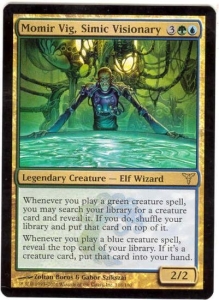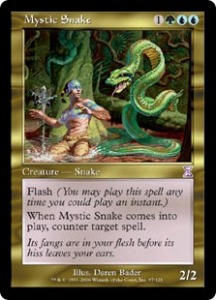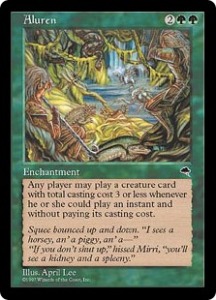For my first post on At the Mountains of Radness, it made sense to me that I should write about something that I talk about a lot but haven’t yet been able to write about – Commander.
Disclaimer: I play EDH to have fun. For me, that includes intricate turns, a lot of value, and making sure that my playgroup doesn’t hate sitting down across from me. Because of that, I tend to avoid cards that only serve the purpose of ending the game quickly (Ashnod’s Altar, Cyclonic Rift).
2nd Disclaimer: I try to mention (almost) every card’s purpose in the deck, so this can get kind of long. If you’re just interested in the list, I’ll have a link that you can follow to see the complete deck.
For the debut post, I’ve decided to talk about my newest Commander deck, Momir Vig, Simic Visionary.
(For anyone who would like to be able to see the cards I’m talking about, here is a link to the list on TappedOut. http://tappedout.net/mtg-decks/momir-vig-commander-visionary/)
Momir Vig is a powerhouse of a general, whose ability lends itself to toolbox creatures and combo all-stars. For this build, I’ll be focusing on the toolbox variety, specializing in low-cost creatures so that we can get the most value out of him.
If you like consistency, value, and a lot of play to your decks, Momir Vig is an amazing option. In addition to the oodles (and I mean oodles) of value you’ll get, he also allows you to win whenever you’d like if you decide to play Craterhoof Behemoth or combo creatures like Vorinclex and Palinchron, but that’s not necessarily my style.
The main reasons not to play Momir Vig are relatively silly, but I wouldn’t blame you. The foremost reason is simply, “If you do not like to shuffle your deck, do not play Momir Vig.” Also, if you’re indecisive and take a long time tutoring, you’ll tend to annoy everyone in your game. But then again, maybe your win con is getting your friends to leave because it’s two a.m. and they have to sleep before they go to work.
Playing the Deck
Depending on how familiar the players in your game are with your list, the late Simic guild leader can draw a lot of hate, since his effect is so powerful, so try to be cautious when casting him so as to get as much value as possible before he’s removed.
That being said, this list is fairly tame. While it’s not an overly complicated deck, practice will save you a lot of time. The first game or two will take a very long time simply because of how long you’ll spend tutoring, since you want to use Momir’s ability as often as possible, even if a problem hasn’t presented itself yet, since Momir will probably be dealt with by the time you need him.
The nature of this commander, though, allows for a lot of play and interaction with the game, something that green decks don’t always have. He’s also really good if you have “pet cards” that you love to play with, as pretty much any colored creature can get some value out of him, and you can see whichever ones you like every game.
There are a few different categories that the creatures of the deck will fall under (and I play 47, including the man himself), so we’ll look at them first.
The Hard Tutors
Momir Vig’s ability allows you to search your deck for a creature and put it on the top of your library when you play a green creature, and lets you reveal the top card and draw it (if it’s a creature) when you play a blue creature.
This means that any Blue/Green creature lets you tutor your deck for a creature and put it into your hand. The kings of both colors are usually cards that fit into other categories, but it’s a good place to start.
Coiling Oracle, Wistful Selkie, Edric, Spymaster of Trest, Shardless Agent, Trygon Predator, Mystic Snake, Jungle Barrier, Prophet of Kruphix, Kruphix, God of Horizons, and Prime Speaker Zegana all have both symbols in their casting cost, and apart from Jungle Barrier and Wistful Selkie, they all are powerful cards. You’ll generate a lot of advantage with all of the tutoring, but cantrips are always nice, too.
The other way to tutor is to play a green creature that cantrips, as you’ll search before it comes into play, then draw the card you searched for.
Elvish Visionary, Wall of Blossoms, and Carven Caryatid are all solid early game cards, even without Momir Vig out, and the added value never hurts.
The Answers
The obvious upside to tutoring is being able to find the bullets for the problems you’re facing. The decks your playgroup contains will alter the list a bit, but I’ve included some generic ones here.
Plaxmanta is a card that helps protect Momir Vig, and it’s a card that people usually don’t expect to see.
Void Stalker and Duplicant are your key removal spells, while Phantasmal Image and Sower of Temptation let you keep up with the decks playing more fatties.
Reclamation Sage, Wickerbough Elder, Acidic Slime, and Trygon Predator are the much-needed artifact and enchantment hate, and usually the most common early targets.
Venser, Shaper Savant, Mystic Snake, Glen Elendra Archmage, and, to a lesser extent, Voidmage Husher, are the bulk of your permission.
Venser also falls in with Dream Stalker, Invasive Species, Aether Adept, and Temur Sabertooth as your ways to replay all of the answers you need to use again, or just gain value with cards like Mulldrifter and Thragtusk.
Mana Dudes
The majority of your ramp should be creature based, to add to the consistency, so just throw whichever guys you like in. My suite includes Birds of Paradise, Fyndhorn Elves, Elvish Mystic, Farhaven Elf, Wood Elves, and Shaman of Forgotten Ways.
The Value and “Because Why Nots?”
Eternal Witness is a staple, but Loaming Shaman is often just better. Between the two of them, you’ll always have what you need, as E-Wit is your “Oh s**t” button, while Loaming Shaman favors the long game in letting you rebuy all the value guys that have died early on.
Edric, Spymaster of Trest, Prime Speaker Zegana, Mulldrifter, and Soul of the Harvest are your main draw spells, with Magus of the Future and Thassa, God of the Sea giving you some virtual advantage, as well as helping when to time your mono-blue creatures to get the most value.
Teferi, Mage of Zhalfir and Prophet of Kruphix, while both being insanely busted regardless of situation, are your Vedalken Orreries.
Kruphix, God of Horizons lets you have a tutorable Spellbook effect, Wonder lets you give your weenies some evasion, and Kessig Cagebreakers gives you the post-wrath push.
To round it out, the fatty of the deck is Tidespout Tyrant. Usually involved in your winning turn (giving you the only “combo kill” effect you have when paired with Aluren and the bounce guys), he’s still really, really good before you intend to win the game. Unlike Craterhoof Behemoth, who would fill the slot otherwise, this card allows you more play rather than just ending the game, and gives you a generic answer to just about anything.
The Non-Creature Junk
Sol Ring, Coalition Relic, Cultivate, and Kodama’s Reach round out the deck’s ramp. While the deck has a generally low curve in comparison to most decks, you want to be casting three or more spells a turn, so you still need a fair amount of mana.
Green Sun’s Zenith is the sole tutor, and it’s not really necessary. I’m just a consistency nut, so having access to your creatures on the turns when Momir Vig isn’t out is helpful.
Voidslime, Delay, and Counterspell are the remainder of my permission, giving me cheap answers to the problem cards I’m not ready for, rather than locking someone out. It’s hard to out-value the deck, so usually other players rely on a single haymaker to swing the tide in their favor.
Beast Within, Song of the Dryads, and Krosan Grip are my generic answers. Nothing special to say here, just that they’re always good in green decks.
Crystal Shard and Equilibrium give me a constant stream of bounce effects to keep my value guys in top shape, and Equilibrium can be a headache for other creature decks.
Rhystic Study is good.
Aluren is really the only true combo card in the deck, and I’m fine with that since it’s not tutorable. It’s bonkers when you have some bounce guys and a value creature or two, or just game-ending when you have tidespout tyrant. Also, I have had a playset of them signed by the designers/pilots of the Legacy deck in 2010, Gerry Thompson and Cedric Phillips, and I’ve been itching for a chance to use one.
Lands
The lands are nothing special.
Breeding Pool, Temple of Mystery, Thornwood Falls, Simic Guildgate, Simic Growth Chamber, Hinterland Harbor, and Command Tower all give me both colors, while Terramorphic Expanse functions as a bad version of Misty Rainforest.
Faerie Conclave and Treetop Village give me a few wrath-resilient threats.
Strip Mine, Tolaria West, Reliquary Tower, and Temple of the False God are all pretty generic, with Riptide Laboratory rounding out the nonbasics.
While a land that can protect Momir Vig is good enough to include regardless (yes, he’s a wizard), Riptide Lab also squeezes out extra value from Prime Speaker Zegana, Sower of Temptation, Glen Elendra Archmage, Venser, Shaper Savant, Aether Adept, Voidmage Husher, and Wistful Selkie, as well as helping protect Magus of the Future, Prophet of Kruphix, and Teferi, Mage of Zhalfir.
Throw in 12 Forests and 11 Islands and you’ve got the list finished.
Thanks for reading! Have an EDH deck you want to see built? Email me at kougadm@yahoo.com with the subject “Commander Deck Idea” and I may just put together a list and write about it!
I’ll see you guys next time!






http://gatherer.wizards.com/Handlers/Image.ashx?multiverseid=369069&type=card
You ain’t ’bout that life.
LikeLiked by 1 person
In a world where I play more permission, Plasm Capture is one of my favorites. I just really, really like tapping out with this deck, so i need my noncreature permission to be cheaper.
LikeLike